The Lenovo ThinkPad X1 Carbon Review (2015)
by Brett Howse on May 21, 2015 8:00 AM EST- Posted in
- Laptops
- Lenovo
- ThinkPad
- Ultrabook
- Broadwell-U
System Performance
The review unit that I received should be no slouch for performance, since it has the Intel Core i7-5600U processor. We have seen a few Broadwell powered notebooks already this year, including Core M and Core i5 models, but this is the first Core i7 that has come across my desk. The i7-5600U is a dual-core processor with Hyperthreading, and it has a base frequency of 2.6 GHz and turbo of 3.2 GHz. All of this processing occurs within a 15 watt TDP.
The memory is 8 GB of DDR3L-1600, and it is in dual-channel mode. Graphics are the Gen 8 Broadwell graphics with 24 Execution Units and the GPU is 300-950 MHz.
The final piece of the performance puzzle is storage, and this X1 Carbon has the fastest SSD available for a laptop in it. The Samsung SM951 drive is a 512 GB PCIe SSD, and despite the lack of NVMe in this particular model it is a potent offering. Kristian reviewed the SM951 in great detail so if you want all of the particulars, check that out.
Performance Graphs
For performance workloads, the X1 Carbon was run through our standard laptop workload. For comparison, I have chosen a sample of other Ultrabooks and other similar devices like the Surface Pro 3, and I have also included the 2013 X1 Carbon as well which had the i5-3427U processor, but if you would like to compare the X1 Carbon to any other device we have tested, please use our Laptop Bench. I have seen some questions about why some devices are not included in all of the results, and it boils down to our benchmark workloads are always evolving, so older devices would not have been run through some of the newer workloads. We do not get to keep all of these devices in order to go back and re-run older ones through the new workloads.
PCMark
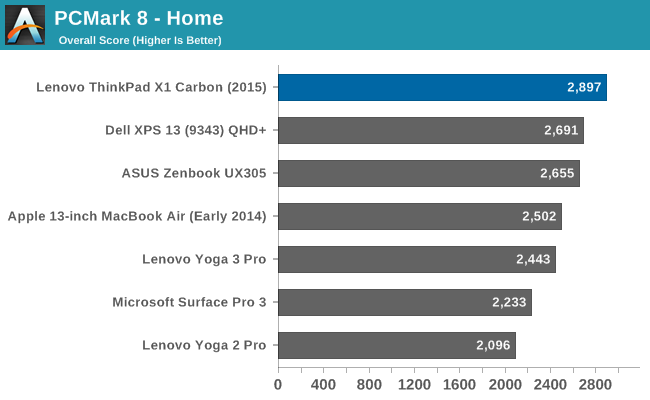
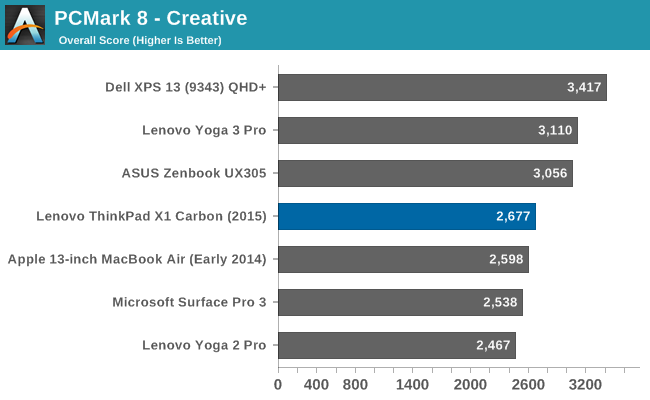

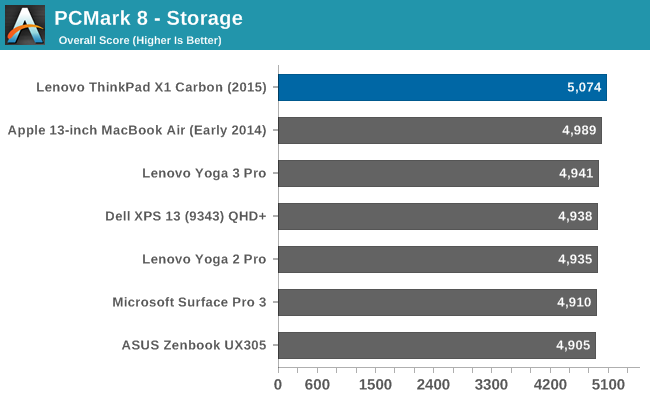
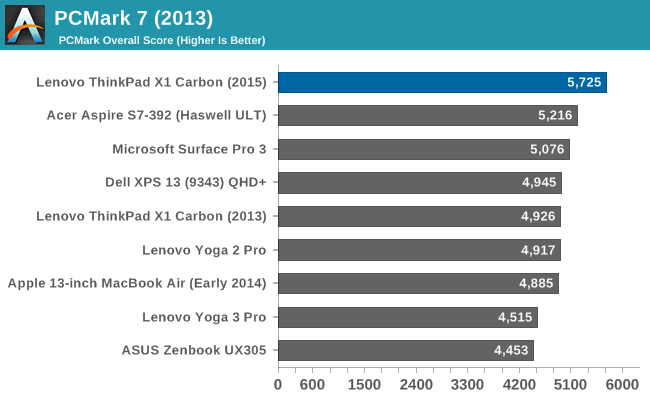
PCMark tries to replicate real world use scenarios with its various workloads. It will have sustained performance as well as burst performance requirements, and storage is also a factor in the scores. Overall, the X1 Carbon aces these tests with its combination of i7 processor and PCIe SSD. The PCMark storage score shows the X1 Carbon as the fastest device we have tested, but due to the nature of the benchmark the scores are all very close to each other. Make no mistake though. This is a drive that can read at 1500 MB/s. For a full breakdown on the drive, please check out Kristian’s review linked at the top of this page.
Cinebench

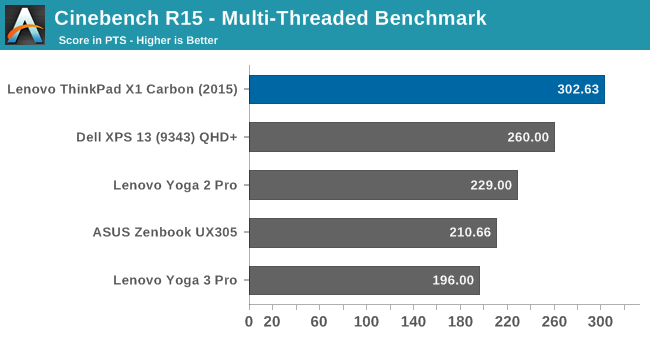
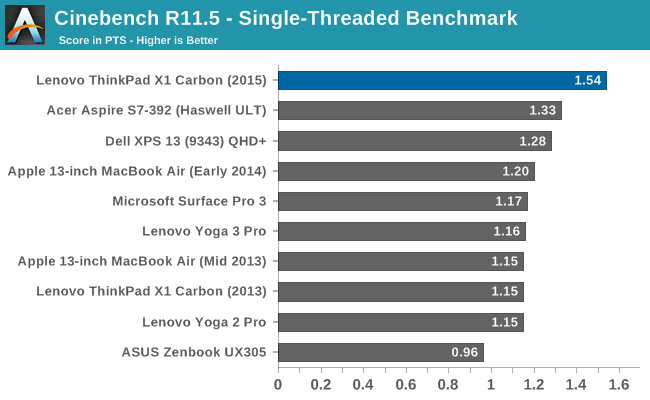
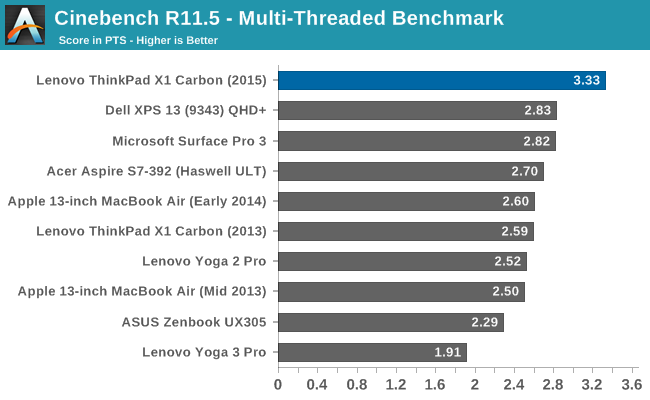
Cinebench renders an image, and can leverage multiple cores. It loves IPC and frequency, both of which the i7 has in abundance, so the X1 Carbon sits at the top.
x264
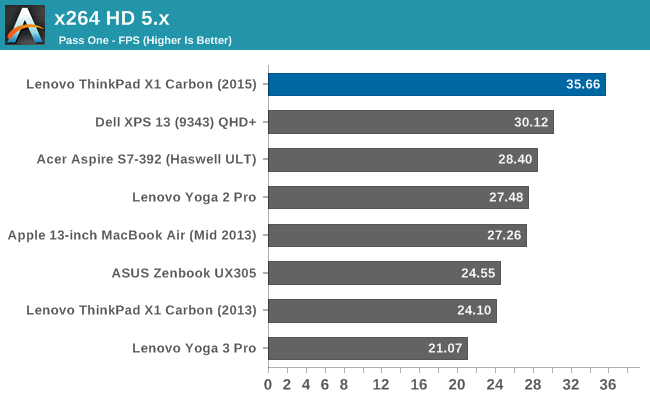
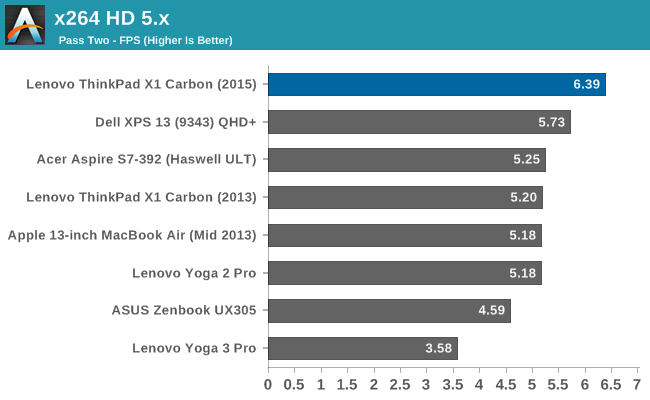
This test converts several videos, and much like Cinebench it loves more cores and higher speeds. The i7-5600U easily passes all over U class notebooks we have tested in this test. This test is all about sustained performance, since it can last an hour or more.
Web Tests
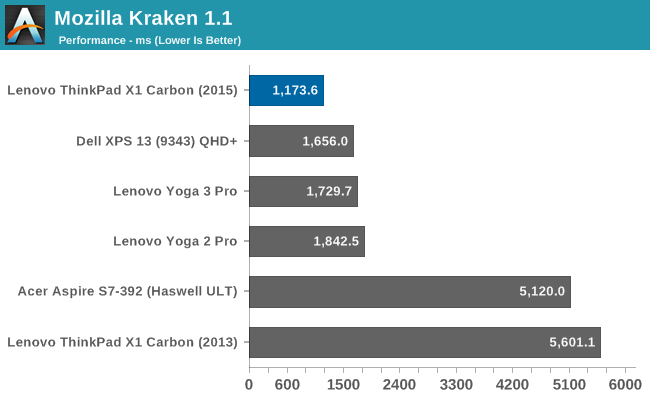
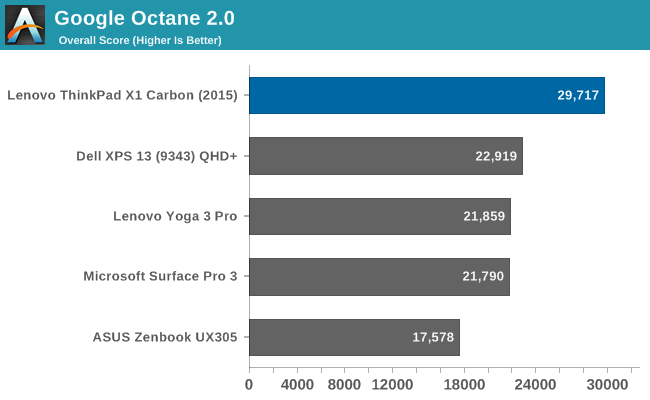
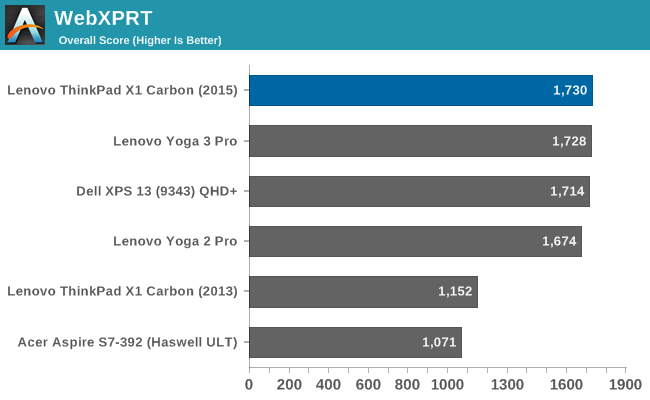
With a 3.2 GHz turbo frequency, the i7-5600U has no issues with javascript. As you can see in these results, it is by far the fastest Ultrabook tested in these kinds of short workloads.
System Performance Conclusion
With 8 GB of memory, a Core i7 processor, and the fastest consumer SSD available, day to day tasks on the X1 Carbon are done with ease. This is easily one of the fastest Ultrabooks around when configured as the review unit is. I don’t love that the base model comes with just 4 GB of memory, but the cost to move to 8 GB is not a lot and should be done by all prospective buyers. I’m not sure if we are at the point where 16 GB of system memory would be needed in an Ultrabook, but it likely will not be long before that does happen.










103 Comments
View All Comments
Chloiber - Monday, May 25, 2015 - link
Sounds to me like a layer 8 issue right there.drwho9437 - Sunday, May 31, 2015 - link
So I have owned a T60, an X200, an X220 and an X230.I sold the T60 to get the X200 because I wanted something smaller. No issues with it until sale. I still have the X200 only failure is a small crack in the bezel that I caused by picking it up pinching the right hand side of the screen for years and years.
I got my mother a T61 which did seem to develop a firmware issue after 2 years (it was already 10 years old; I had gotten it used). I replaced it with a T400 which is working well.
My X220 was working fine when I sold it. It had always run a little hot for my taste so I replaced it with the X230 as I had a chance to use the new style keyboard and found it not completely unacceptable.
Friend of mine has an X201t no issues. I got an X300 off ebay for next to nothing, it does run hotter than I would have thought for so low a power CPU but the fan is tiny. One mouse button didn't work so I got a new set for few dollars.
All in all some failures to be sure but I have yet to have a single failure in year 1, that said I always buy them refurbished from the outlet or used. Perhaps those get more testing. They cost about 75% of new too, with a longer 3 year warranty in most cases. I just wait until what I want shows up on the outlet and then get it. The need for the newest computer available is long over.
carbonx1_is-the-worst - Friday, May 22, 2015 - link
Battery broke completely within 18 months for no apparent reason - one day my laptop simply said 'no battery'. Replacement part order took forever - had to call IBM that handles parts for lenovo. part cost over $160 with shipment; installation cost $50 by geeksquad. Once installed, new battery runtime = 4h which is 50% of IBM-tech-support-promised capacity for the new part which was supopsed to be exactly the same OEM as in the brand new laptop. Now, dealing with faulty part replacement - which is another ordeal -- first you call IBM "supplies" number recommended on the packlist; then IBM send you an email with instruction to forward that email to 'returns' - etc. I think they dropped a ball here - the process could have been much more COMPLICATED so no one ever bothers with replacement requests. For instance, IBM could have gently recommended to write a letter by hand with special golden-sparkle-inc explaining the reasons for exchange order, then pack the letter in the eggshell colored in black, then put the eggshell in the treasure box of size 10x10cm, then put that in the oversized envelop with sufficient amount of cushioning, and at last, courier-deliver that to a special location in PA and give a secret knock on IBM/Lenovo door: knock-knock --- triple knock.protomech - Saturday, May 23, 2015 - link
Wat? You went back to a 2010 laptop over a new 2015 because it offers better battery life?That's.. surprising.
beastly - Sunday, November 29, 2020 - link
I have the X1 Carbon as well and it has easily. 19 hr life and charges in about 40 mins to 100%. The biggest factor for laptops not living up to the estimated battery life generally has to do with USB devices drawing off that battery. I use a powered USB hub to prevent battery drain from slave USB devices.lilmoe - Thursday, May 21, 2015 - link
Really, battery life is a bummer for an otherwise great, expensive machine. But ultrabooks aren't for people like me anyway (also a developer; VS2013/15). I wouldn't mind the extra thickness, performance and weight of the T450s with its hot swappable battery.sorten - Thursday, May 21, 2015 - link
I guess it depends what you're developing. For me personally, performance has always been more important than battery life because my laptop is docked and attached to two monitors for 95% of my dev time. The only time battery life is a concern is when I'm stuck in all day planning sessions. If I'm undocked and programming on the couch or in some open space at the office then I'm concerned with heat and, to a lesser extent, noise.mmrezaie - Thursday, May 21, 2015 - link
I have a decent Xeon workstation and some other clusters. I need something with decent performance that I can take where ever I go and also with best class battery. Something that thinkpad was. Actually some of my colleagues chose x250, but somehow I prefer the macbook pros.mmrezaie - Thursday, May 21, 2015 - link
which is not remotely as durable as I would like. You should have it for a year to see what happens to it.lilmoe - Thursday, May 21, 2015 - link
Having both would be great (and I really love the ability to hot swap batteries). I'm a freelance developer and I have my own LoB software. I use lots of rich controls, so Visual Studio could use all the oomph it can get. WPF can be harsh at design time, even WinForms can with lots of nested table layout panels. I was shopping around last year for a new Haswell MQ/HQ laptop around the time when Lenovo kind of MESSED UP the trackpad among other things.....I don't like U-series CPUs so I opted for a 4702MQ HP ProBook and it's been great. I installed decent quality 16GB RAM modules and a Samsung 850 Pro to help. I'm getting 3-4 hours of heavy usage and, now after Windows 10, up to 8 hours of light use and browsing on Edge (used to be less than 7). But I seriously HATE the TN panel, and I've been shopping around for an IPS replacement part (still waiting on the HP agent in my country) since none of the models I've seen had IPS.
I really LOVE Thinkpads, but Lenovo just has to mess something up. I can live with a not-so-great screen and so-so battery life if performance was great, but a trackpad with no physical buttons and good travel (on the bottom of the pad)?? Heck no. Not even the clicky type buttons. I hope they get those back next gen.
I have my eyes on the T550 since I need the numpad, hope the next gen will have hot swap batteries like the T550s. Anandtech really need to do some comprehensive testing of the T-series, and not only U-series alone.